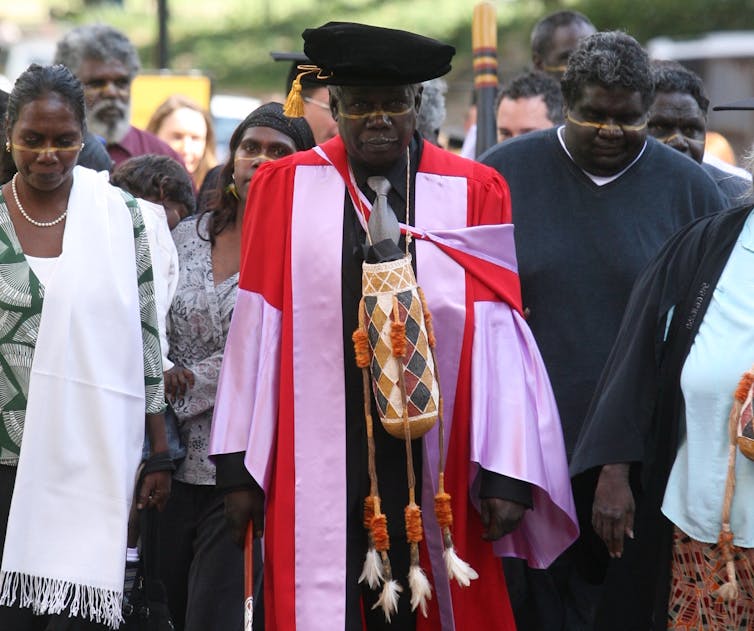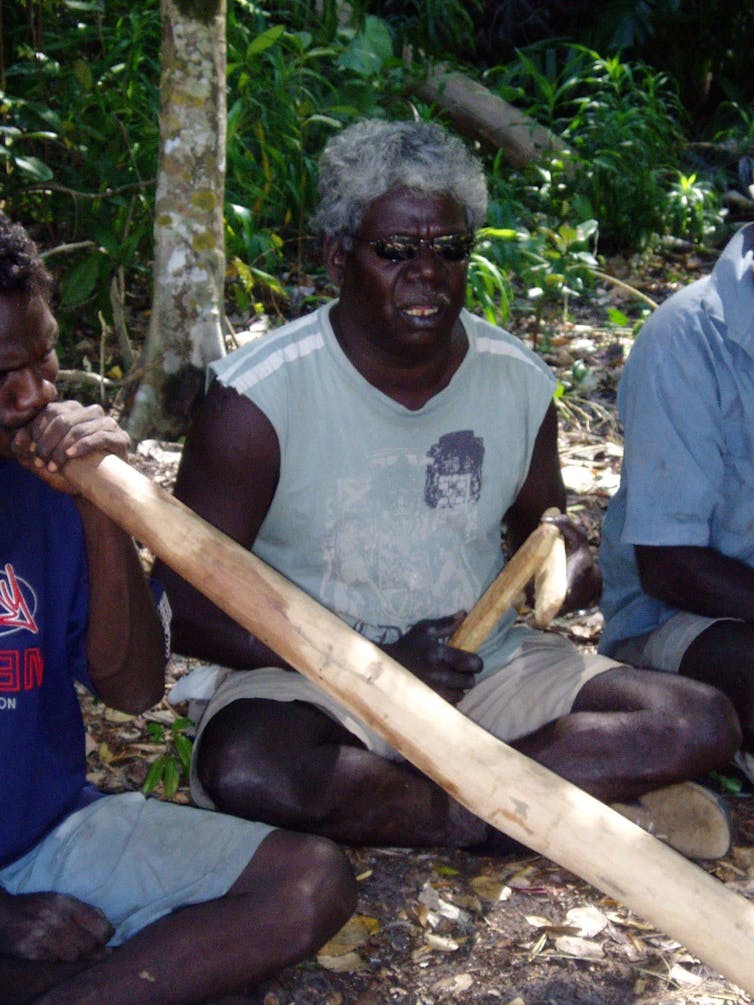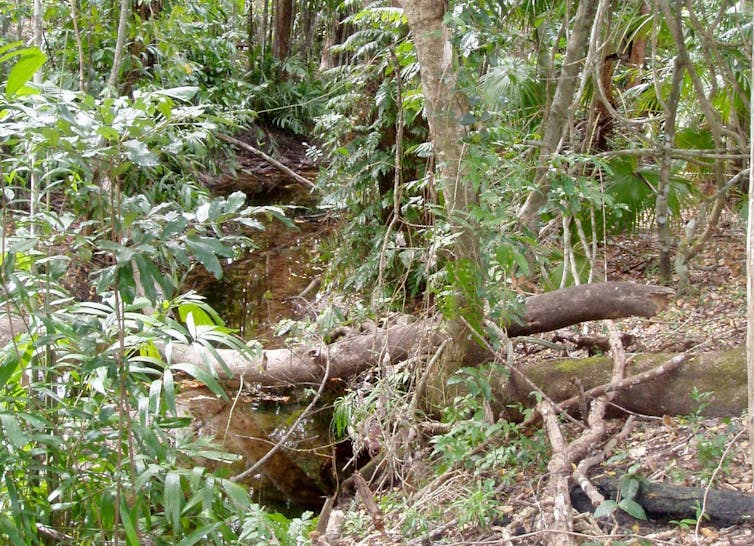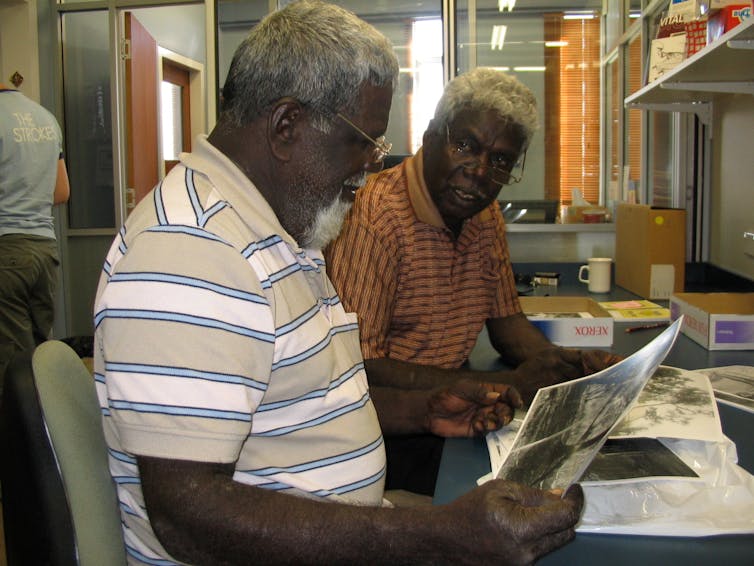Friday essay: Dr Joe Gumbula, the ancestral chorus, and how we value Indigenous knowledges
- Written by Aaron Corn, Professor of Music and Director, Centre for Aboriginal Studies in Music (CASM) and National Centre for Aboriginal Language and Music Studies (NCALMS), University of Adelaide
In September 2001, the preeminent Indigenous elder and public intellectual, Dr Joe Gumbula, spoke to a class of students at the University of Melbourne. In death, he told us, he would no longer be Joe Gumbula. He would no longer need that name, he said, because the ancestors of his most sacred homeland, Djiliwirri, had already named his corporeal body for features of the living environment as recorded in song.
His knees, he said, are the fruit of the native apple tree.
His feet and legs belong to the emu, as does his heart and his stomach.
His front belongs to the ancestral ghost, Murayana, while his back is Murayana’s iconic hollow log coffin.
His spine is the pathway worn through the scrub by the koel cuckoo.
His eyes are nuts of the cycad palm.
His white hair is made of the fine wispy roots of the paperbark tree and the foam they produce in the swamp during the Wet Season at Djiliwirri.
His head and all his knowledge are honeycomb from the hive of the Honeybee ancestor, Birrkuda. His nose is beeswax, and his mouth is the entrance to the beehive.
 Gumbula with his family receiving his honorary Doctor of Music degree at the University of Sydney in 2007.
Author provided
Gumbula with his family receiving his honorary Doctor of Music degree at the University of Sydney in 2007.
Author provided
Gumbula, who passed away in 2015, was one of Australia’s greatest thinkers. Now, his name is Birrkuda, the Honeybee. His voice has joined the ancestral chorus at Djiliwirri, where he dwells for all of time, and there, within the living environment, his songs can still be heard by those who attend to listen.
Honey from the paperbark tree
Born in Miliŋinbi (Milingimbi) in 1954, Gumbula was descended from a prominent line of Yolŋu leaders of the Gupapuyŋu clan from northeast Arnhem Land, whose contributions to understanding between Indigenous and other Australians have been influential since the 1920s. Researching the representation of his parents and grandparents in ethnographic and art collections worldwide became the passion of his life’s work.
Gumbula apprenticed as carpenter in his teens, and moved to Galiwin’ku in 1971, where he became a lifetime member of the seminal Yolŋu country and gospel band, Soft Sands. From 1989 to 1996, he served as a sworn officer of the Northern Territory Police Service, retiring with the rank of Constable First Class and a commendation for bravery.
He simultaneously became a recognised master-singer of Manikay, the exquisite Yolŋu tradition of public ceremonial songs. The academy struggles to recognise intellectual expressions outside the medium of text, yet the Manikay tradition perpetuates a body of knowledge that has enabled the Yolŋu to live in Australia for untold millennia.
Manikay as performed in a public ceremony in Ramanginiŋ in 2008.I first met Gumbula at his home in Galiwin’ku in November 1997 while undertaking my PhD research on contemporary popular music in Arnhem Land. He adopted me as his child - a common enough occurrence for which Yolŋu law provides.
Gumbula had been composing his own rock songs since 1985, and had recently found new work as a vocational trainer in contemporary music skills for Northern Territory University. He proudly showed me the new music-video that he had just completed for his most-loved original song, Djiliwirri, which celebrates the continuity of Gupapuyŋu clan law from his parents’ generation to the present. Named after the most sacred homeland of the Daygurrgurr Gupapuyŋu clan, it remains a visionary work that incorporated clips from the 1964 documentary film, Djalumbu, which featured Gumbula’s father, Djäwa, leading a public hollow-log burial ceremony at Miliŋinbi.
“Djiliwirri” composed by Joe Gumbula and Fred Dhamarrandji, and performed by Joe Gumbula with Soft Sands in 1997.In September 1997, just before we met, Gumbula had completed a long and arduous process of learning to become a leader of public ceremonies. He had attained mastery in performing his hereditary Manikay, and had learnt to conduct large complements of singers, dancers and artists in ceremony across a complex array of contexts. By building his expertise in Yolŋu law, he had accrued sufficient märr (essence) to earn the right to lead public ceremonies, and had been recognised by his elders as one who is liya-ŋärra’mirri: learned and wise.
Further reading: Friday essay: the remarkable yidaki (and no it’s not a ‘didge’)
As a function of my adoption as his child, Gumbula first taught me how to accompany on yidaki or didjeridu so that he could sing Manikay whenever we travelled together. He coached me in closely studying the musical and lyrical content of the Manikay series that he regularly performed and the knowledge codified within it. Over the years of this process, I came to understand fine details about Gupapuyŋu clan homelands and ceremonies that I could not have learnt by any other means.
How sulphur-crested cockatoos perch in lofty paperbark trees to cry for the dead.
How emus stomp the earth and soak their feathers as they drink from freshwater streams.
How the poisonous spines of eel-tailed catfish protect the souls of the newly deceased like warriors’ spears.
How tortoises comb through white weeds on the floor of the lake at Gapuwiyak, just as elders comb white clay through the hair of youths being readied for initiation.
These are among the myriad natural phenomena of the Yolŋu homelands that the Manikay tradition records and ascribes ceremonial significance. They are repeatedly observable both in nature and in the ways that Yolŋu engage with them.
Singing ancestral records
In Yolŋu epistemology, whenever people sing Manikay, their voices are not their own, but rather mingle with those of the ancestors themselves - all those who have gone before and all those who are yet to be. The Manikay tradition codifies all the observations and strategies for living given to the Yolŋu by the original ancestors who originally named, shaped and populated their myriad homelands in northeast Arnhem Land.
 Gumbula sings his hereditary Manikay for the archival record at Djiliwirri in 2004.
Author provided.
Gumbula sings his hereditary Manikay for the archival record at Djiliwirri in 2004.
Author provided.
Songs are typically organised into lengthy series of subjects that enumerate intimate details of each homeland and its living ecologies. The natural species and cycles found on each homeland - as observed by the original ancestors - are the substance of these songs.
Together with interrelated repertoires of sacred names, dances and designs, the Manikay tradition informs the logic of ceremonial practices through which the Yolŋu observe and express their law. To be a Manikay singer is to be trained in Yolŋu law, to know how to lead public ceremonies, and to know how the myriad features of the Yolŋu homelands are recorded in song.
For the Yolŋu, the Manikay tradition expresses fundamental truths about the nature of human existence within the greater fabric of the natural order. They understand Manikay repertoires to stand as an evidential record of the Yolŋu homelands that has been passed from the original ancestors to their living kin over successive generations.
Memories of the living fade, yet the agency of ancestors is realised anew each time Manikay is performed. The Manikay tradition is therefore regarded to be a formal medium through which the Yolŋu convey their intimate knowledges of country and its ancestral histories, and consolidate philosophical interpretations of the nature of existence from one generation to the next.
Yet each new performance of any given song item within the Manikay tradition is also deliberately unique to capture the aesthetics of the endless variability found in natural forms. Manikay repertoires are built around stock words and phrases, including strings of sacred names for all things observed by the original ancestors, and stock melodies and rhythms that are constantly varied in subtle ways. Cryptic in tone and replete with archaisms stemming from ancestral times, their lyrics defy narrative linearity, and can be ordered and reordered - interpreted and reinterpreted - quite differently with each new performance.
In these respects, the Manikay tradition is both a creative and an intellectual medium, as well as a sacred one. Singers become seasoned thinkers who curate and extend the contents and contexts of their performances to mediate ancestrally-informed understandings of the nature of existence and theorise their relevance for today. It expresses a balanced interplay between tradition and innovation in thought and practice that Yolŋu typically liken to an ancestral campfire site, where each new generation of the living adds its own layer of ash.
Thinking through songs
I have spent my entire career collaborating with thinkers, such as Gumbula, who come from outside European intellectual traditions. Their relationships with the academy are sardonically illustrated by the Iranian philosopher, Hamid Dabashi, who asks, “Can non-Europeans think?” He questions why the work of European philosophers is just plain philosophy, while they deem their African counterparts to be ethno-philosophers. Why is it, asks Dabashi, that Mozart is a composer of music, while equally-sophisticated Indian musical expressions are the subject of ethno-musicology?
 The source of a sacred freshwater stream at Djiliwirri in 2004.
Author provided
The source of a sacred freshwater stream at Djiliwirri in 2004.
Author provided
It is through this systemic lens of alterity that the academy has typically engaged with the Manikay tradition, and indeed all Australian Indigenous expressive forms. It typifies them as conduits for cultural ideas and values, and perhaps even spiritual and political ones, but rarely intellectual ones.
Clearly, learned exponents of the Manikay tradition, and others like it, should be considered thinkers in their own right. But what of the myriad media through which such thinkers choose to express their ideas?
For most intellectuals within Euro-diasporic traditions, the arrangement of typographical characters on a white page is a tried and familiar medium for communicating theoretical ideas built upon observable evidence with reference to existing scholarly findings. Scholars within these traditions, myself included, are trained from an early age to know that books and other texts can convey facts and, therefore, knowledge.
We know that not all books and texts are factual. Yet this never brings into question the prevailing academic assumption that text is the ideal medium for conveying evidential knowledge that is observable and repeatable.
But what if there were other media that, like text, were so intimately associated with language, that they too could convey knowledge in such ways? Academics routinely entrust text and, to a lesser extent, film with conveying their original contributions to human knowledge. We usually do this unquestioningly on the basis of established precedents. Does not the Manikay tradition, with its own intimate relationship with audible language stretching back to established precedents in ancestral times, exhibit comparable mechanisms for conveying meaning?
The Manikay tradition has been carefully curated over successive generations to maintain an observable and repeatable record of this expansive body of knowledge, while simultaneously being able to accommodate both reinterpretations of old observations and additions of new ones.
 Gumbula working with his brother, Milaypuma Gaykamaŋu, in the University of Sydney Archives in 2007.
Author provided
Gumbula working with his brother, Milaypuma Gaykamaŋu, in the University of Sydney Archives in 2007.
Author provided
Learned singers of Manikay constantly reset and reinterpret the themes and meanings of their repertoires in response to arising circumstances of celebration, loss, negotiation and commemoration. Newer influences upon Yolŋu society, such as its lengthy history of engagements with Makassan seafarers from Sulawesi, have long been recorded as central themes of Manikay series. Each generation of singers leaves its own new layer of ash upon the same ancestral campfire site.
In this respect, Manikay is an archetypal medium of creative practice-as-research. It synthesises thought and practice to cultivate understandings of the nature of existence that equip people with applicable skills for knowing how to live on country and find its inner meanings.
It locates human existence and agency firmly within the continuum of the natural order, and celebrates the undeniable truth that, as humans, we are all products of countless ancestral unions and deeds over countless generations.
But in Australia, research outputs disseminated via media other than text are officially relegated to othering categories such as “non-traditional”, “applied”, “creative” and “practitioner-based”, and are generally considered secondary to “traditional” textual outputs.
If learned exponents of traditions such as Manikay are truly deserving of our recognition as thinkers, then we should also recognise and value the media they have long cultivated to perpetuate their discourses as being equivalent to the written word.
This is particularly relevant to lexically-rich song forms that convey concepts as sophisticated as any standard scholarly writing. Indeed, with the contemporary academy’s tenuous recognition for formal song forms through which philosophical ideas can be conveyed, Yolŋu intellectuals are frequently left wondering whether scholars in Euro-diasporic traditions can think.
This is not only important for exponents of Australian Indigenous traditions such as Manikay that have become highly endangered in the wake of British colonisation. It also crucial for thinkers across the humanities, creative arts and social sciences all over the world, who work beyond the medium of text in ways that are more germane to their disciplines and approaches.
This entrenched bias serves little purpose other than to privilege Euro-diasporic traditions of knowledge production and dissemination that continue to threaten and displace equally justifiable ways of being and knowing cultivated by other societies.
Knowledge across cultures
Gumbula was my most prolific teacher, Yolŋu or otherwise. Driven by his personal quest to trace the extensive legacy of his family’s recorded history, he was adamant from the outset of our relationship that intelligence should flow between us equally in both directions.
He would teach me about Yolŋu music and its centrality to Yolŋu law and knowledge, and I would help him to build networks that would lead him to collections of interest in museums and archives around the world. This grounded our relationship in the ethos of Matjabala, a Gupapuyŋu clan process for forging bonds with other groups to share knowledge and resources through equitable ceremonial exchange.
Gumbula constantly drew on his knowledge of Manikay and its centrality within Yolŋu law to challenge my learnt academic perceptions about what knowledge is, and how it can be manifested. I came to realise that all ethnographic scholarship about the Yolŋu, since its beginnings in the late 1920s, could not have existed without the cooperation of learned Yolŋu leaders who had been willing to engage with visiting academics.
As Gumbula and I taught, wrote and performed together, our aim was not to bring Yolŋu knowledge into the academy, but rather to bring the academy into a more equitable dialogue with equally valid traditions of Yolŋu knowledge production and dissemination. We called our approach not only bi-cultural, but also bi-intellectual.
Gumbula began teaching in Australian Indigenous Studies courses at the University of Melbourne in 2001 and, through his 2003–05 visiting senior fellowship there, embarked on extensive travels to investigate his family’s recorded history in collections around the world.
In association with the National Recording Project for Indigenous Performance in Australia, he and I worked with his family to make archival recordings of their Manikay repertoires through field trips to their remote homelands. Later, at the University of Sydney, he taught in the Australian Indigenous Studies program in 2005–06, and was awarded an honorary doctorate of music in 2007.
 Gumbula with his wife, Pamela Ganambarr, at the launch of his Makarr-garma exhibition at the University of Sydney in 2009.
Author provided.
Gumbula with his wife, Pamela Ganambarr, at the launch of his Makarr-garma exhibition at the University of Sydney in 2009.
Author provided.
Gumbula led three projects funded by the Australian Research Council on Yolŋu collections. In 2009, he curated an innovative exhibition on Yolŋu knowledge at the University of Sydney’s Macleay Museum called Makarr-garma, and his 2011 book on early ethnographic photographs from Arnhem Land, Matjabala Mali’ Buku-ruŋanmaram, received a prestigious Mander Jones Award from the Australian Society of Archivists.
Inspired by photographs found in the Melbourne Museum and in the University of Sydney Archives, his final project was to start the process of producing a rare Makarrata reparations ceremony at Miliŋinbi after a hiatus of some 80 years. He sadly passed away before it came to fruition in August 2016.
Though charming and charismatic, Gumbula was fearless and unyielding. He took pride in challenging colleagues to think and work in new proactive ways. His research leaves an enduring impact upon the ways that scholars and collecting institutions represent and engage with Indigenous peoples, heritage, and knowledges.
This an edited version of the Dr Joe Gumbula Memorial Lecture presented at the 16th Symposium on Indigenous Music and Dance at the University of Melbourne in partnership with the 2017 Information Technologies and Indigenous Communities Symposium convened by Dr Lyndon Ormond-Parker, and the 2017 Australian Society of Archivists Conference convened by Katheryn Dan and Dr Katherine Howard. The author and convenors acknowledge the kind support of Pamela Ganambarr, Farrah Gumbula, Michael Gaykamaŋu and others in Dr Gumbula’s family, and of the Australian Society of Archivists’ President, Julia Mant. A fuller version will be published by MUP in Associations: Creative Practice and Research edited by Dr James Oliver.
Authors: Aaron Corn, Professor of Music and Director, Centre for Aboriginal Studies in Music (CASM) and National Centre for Aboriginal Language and Music Studies (NCALMS), University of Adelaide





